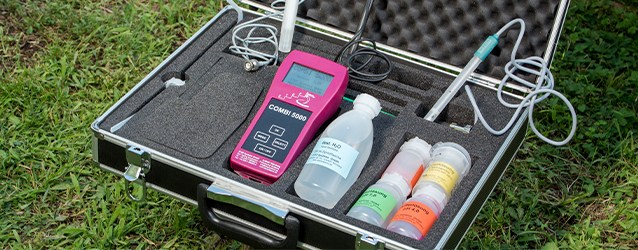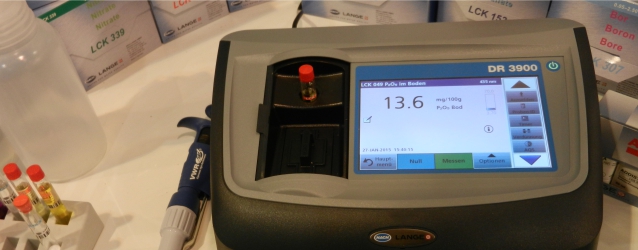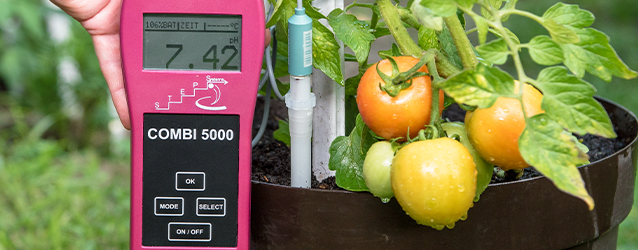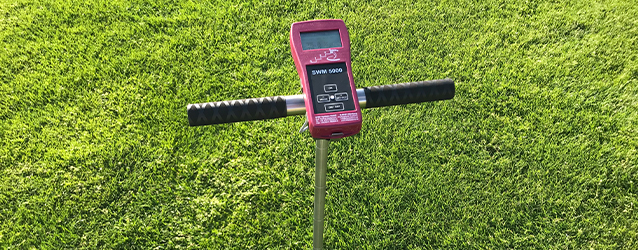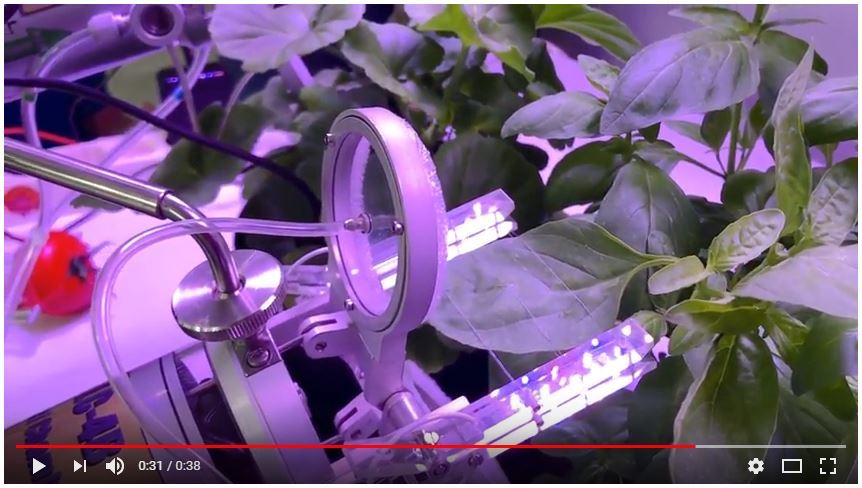- About us
- Products
- pH-Value and Salinity
- Analysis of Nutritional Parameters
- Laboratory equipment
- Light measurement
- Fruit quality control
- Climate Control
- Moisture measurement
- Soil properties
- Gas measurement
- Phyto-Monitoring
- Catalogs
- Trade Fairs
- Contact us
- How to order
Photosynthese Monitor

System Unit PTM-50
The Photosynthese Monitor is truly state-of-the-art system for long-term automatic recording physiological characteristics of intact plants.
Overview
An all-in-one instrument for round-the-clock monitoring of the leaf CO2 exchange, transpiration and stomatal conductance.
The Monitor has 4 inputs for original automatic selfclamping leaf chambers. The chamber is normally open and shuts the leaf only for 30 seconds to take readings of both CO2 and H2O exchange rates. The short measurement time provides minimal disturbance of natural leaf conditions.
The Monitor is a portable 12 VDC instrument and provides fully automatic continuous operation with sampling rate selectable from 5 to 120 minutes.
The Terminal Emulator software (for Windows) allows controlling system setup and operation as well as data downloading and export in TXT or CSV format for further processing and analysis. A simple graphics viewer is also available.
The Monitor has many optional accessories for providing various measurements.

Leaf Chamber
Advantages:
If you know how your plants are structured and how they react and grow, you can tailor your growing methods to maximize your growth and yield.
Sensors for supervising crop growth and tuning climate and irrigation control:
Basic measurements- CO2 exchange of leaf (net photosynthesis, gross photosynthesis, photorespiration, dark respiration)
- Leaf transpiration
- Stomatal conductance
- Photosynthetic radiation
- Air temperature
- Air humidity
- CO2 concentration in the air
- Atmospheric pressure
- Leaf wetness
- Leaf temperature

Sap Flow Sensors
- Sap flow
- Stem diameter
- Fruit growth
- Soil moisture
- Soil temperature
- Soil EC
- Auxanometer
- Pyranometer
- Quantum sensor
- etc.
Field data agronomic interpretation
Phytomonitoring allows evaluation of the physiological reaction of plants within an hour for such processes as photosynthesis and transpiration, and one to two days for growth processes.- Direct observation of data in graphic format, using software to change scales, time spans and sensor combinations, provided by the system.
- Automatic interpretation, using an expert system, including specialized comments and advise of orchard management specialists.

Stem Micro-Variation Sensor
Typical Control Tasks Photosynthesis Monitor:
Protected crops- Optimization of a supplementary lighting, based on daily light curve of photosynthesis.
- The cost of electricity can also be accounted for, when determine the thresholds for turning on the lamps.
- Comparison of various light souces and their space distribution.
- Adjustment of CO2 enrichment.
- Adjustment of air temperature.
- Effect of nutrition.
- Effect of ventilation.
- Effect of shading.
- Comparison of various plant species productivity.
- Distribution of plant productivity inside the canopy.
- Effect of fruit load, picking and harvesting.
- Transpiration monitoring for correction of the daytime and nighttime irrigation schedule.
- Simultaneous monitoring of CO2 and H2O exchange to reveal the stomatal limitation of photosynthesis related to a water stress.
- Effect of fertilization on productivity.
- Detection of insufficient watering at nighttime, due to a common underestimation of nighttime transpiration in
arid and semi-arid climatic zones. - Control of the fruit growth when a standard size is required at harvesting.

Fruit Growth Sensors
Technical data
- Number of leaf chambers: 4
- Leaf chamber area window: 20 cm2
- Standard length of connecting hose: 4 m
- Normal range of airflow rate in the leaf chamber channel: 0.8 to 1.0 lpm
- CO2 concentration measurement range: 0 to 1000 ppm
- Rated measurement range of CO2 exchange: -70 to 70 µmolCO2·m−2·s−1
- Transpiration measurement range: 0 to 150 mgH2O·m−2·s−1
- Built-in Meter for measuring photosynthetically active radiation, air temperature, relative humidity and leaf wetness. Has input for the digital SMTE soil moisture, temperature and EC sensor.
- Number of analog inputs for optional sensors: 8
- Input range for optional sensors: programmable, 0—1 to 0—10 VDC
- Power requirements: 12 VDC @ 60 W max.
- Interface: wireless 2.4 GHz built-in modem with the USB; Wireless adapter for PC
- Terminal emulator and graphics software: for Windows
- Environmental protection index: IP 55
Item-no.: 27000

